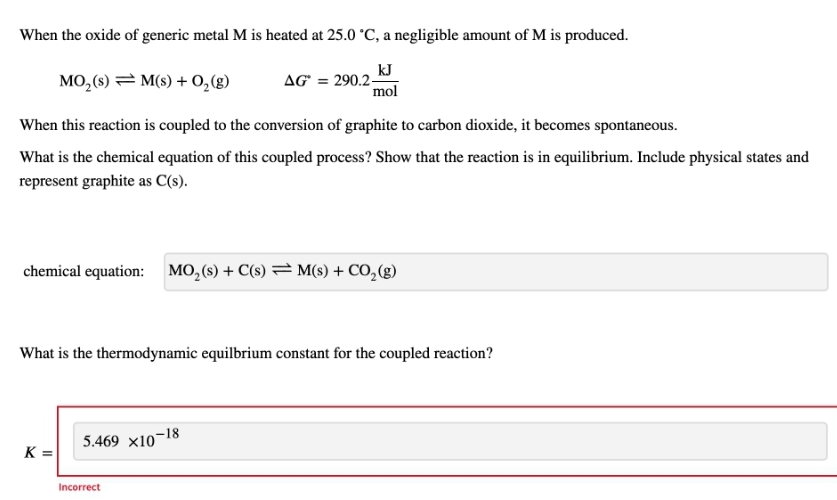When the oxide of generic metal M is heated at 25.0 °C, a negligible amount of M is produced. MO₂ (s) = M(s) + O₂(g) kJ mol When this reaction is coupled to the conversion of graphite to carbon dioxide, it becomes spontaneous. What is the chemical equation of this coupled process? Show that the reaction is in equilibrium. Include physical states and represent graphite as C(s). chemical equation: MO₂ (s) + C(s) M(s) + CO₂(g) What is the thermodynamic equilbrium constant for the coupled reaction? K = AG = 290.2- 5.469 x10-18 Incorrect
When the oxide of generic metal M is heated at 25.0 °C, a negligible amount of M is produced. MO₂ (s) = M(s) + O₂(g) kJ mol When this reaction is coupled to the conversion of graphite to carbon dioxide, it becomes spontaneous. What is the chemical equation of this coupled process? Show that the reaction is in equilibrium. Include physical states and represent graphite as C(s). chemical equation: MO₂ (s) + C(s) M(s) + CO₂(g) What is the thermodynamic equilbrium constant for the coupled reaction? K = AG = 290.2- 5.469 x10-18 Incorrect
Chapter17: Spontaneity, Entropy, And Free Energy
Section: Chapter Questions
Problem 11Q: The synthesis of glucose directly from CO2 and H2O and the synthesis of proteins directly from amino...
Related questions
Question
Kk.325.

Transcribed Image Text:When the oxide of generic metal M is heated at 25.0 °C, a negligible amount of M is produced.
MO₂ (s) = M(s) + O₂(g)
kJ
AG = 290.2-
mol
When this reaction is coupled to the conversion of graphite to carbon dioxide, it becomes spontaneous.
What is the chemical equation of this coupled process? Show that the reaction is in equilibrium. Include physical states and
represent graphite as C(s).
chemical equation: MO₂ (s) + C(s) M(s) + CO₂(g)
What is the thermodynamic equilbrium constant for the coupled reaction?
K
5.469 x10-18
Incorrect
Expert Solution
This question has been solved!
Explore an expertly crafted, step-by-step solution for a thorough understanding of key concepts.
Step by step
Solved in 4 steps with 11 images

Knowledge Booster
Learn more about
Need a deep-dive on the concept behind this application? Look no further. Learn more about this topic, chemistry and related others by exploring similar questions and additional content below.Recommended textbooks for you


Chemistry
Chemistry
ISBN:
9781305957404
Author:
Steven S. Zumdahl, Susan A. Zumdahl, Donald J. DeCoste
Publisher:
Cengage Learning

Chemistry: An Atoms First Approach
Chemistry
ISBN:
9781305079243
Author:
Steven S. Zumdahl, Susan A. Zumdahl
Publisher:
Cengage Learning


Chemistry
Chemistry
ISBN:
9781305957404
Author:
Steven S. Zumdahl, Susan A. Zumdahl, Donald J. DeCoste
Publisher:
Cengage Learning

Chemistry: An Atoms First Approach
Chemistry
ISBN:
9781305079243
Author:
Steven S. Zumdahl, Susan A. Zumdahl
Publisher:
Cengage Learning

Chemistry & Chemical Reactivity
Chemistry
ISBN:
9781133949640
Author:
John C. Kotz, Paul M. Treichel, John Townsend, David Treichel
Publisher:
Cengage Learning

Chemistry: Principles and Practice
Chemistry
ISBN:
9780534420123
Author:
Daniel L. Reger, Scott R. Goode, David W. Ball, Edward Mercer
Publisher:
Cengage Learning

Chemistry for Engineering Students
Chemistry
ISBN:
9781337398909
Author:
Lawrence S. Brown, Tom Holme
Publisher:
Cengage Learning